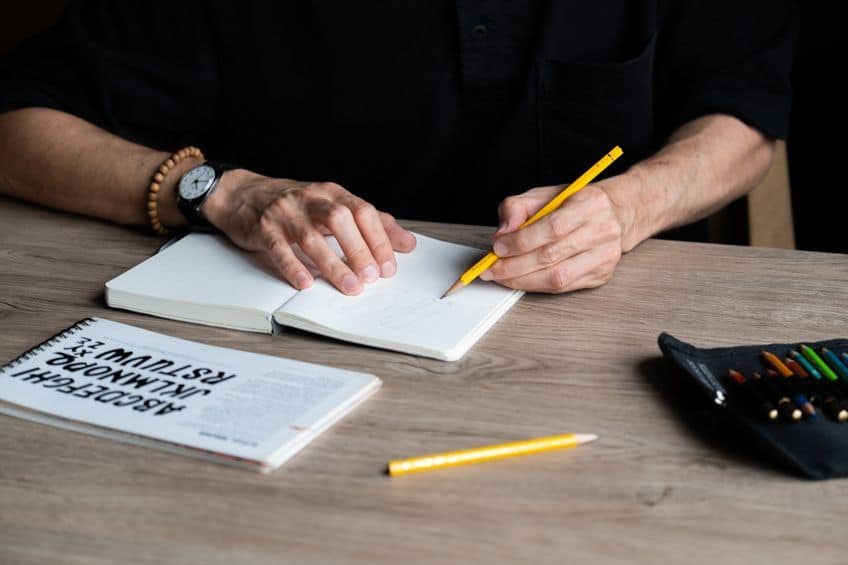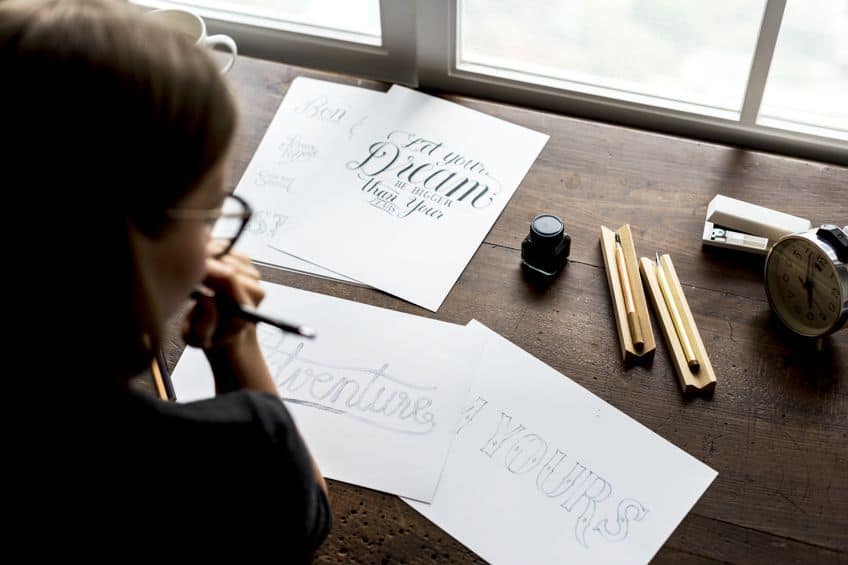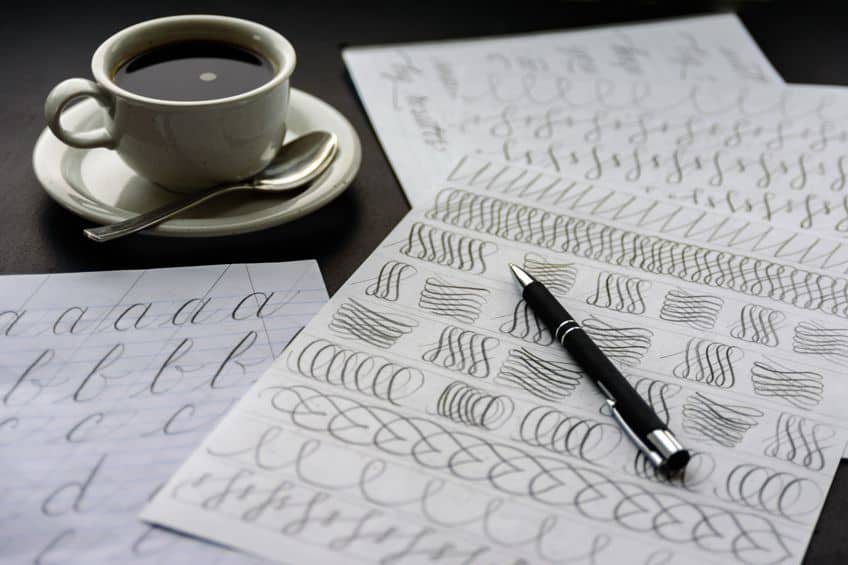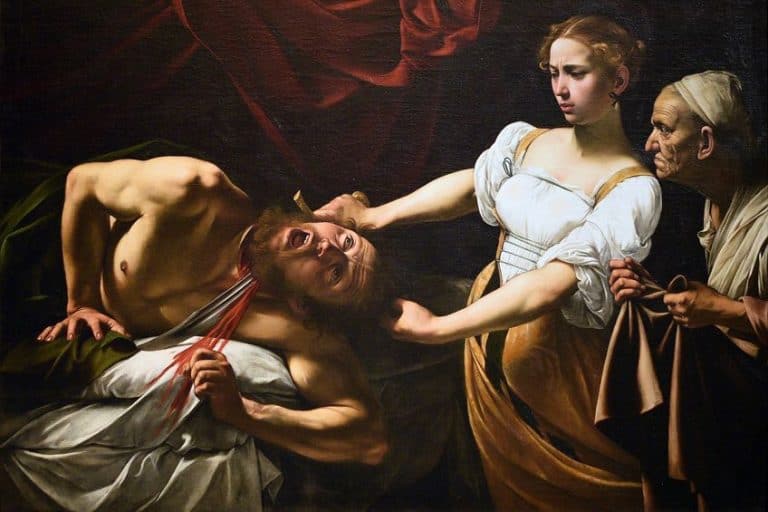What Is Calligraphy? – The Art of Calligraphy Styles
You might think the definition of calligraphy is as simple as decorative handwriting, but there is much more to this writing style than you expect. The onset of technology has also had a great influence on calligraphy styles. However, nothing can replace the old methods and process of creating beautiful writing by hand. So, to get a clearer understanding, let us look at the various types of calligraphy and what calligraphy is used for.
What Is Calligraphy?
The most basic definition of calligraphy is that it is a handwriting skill or simply beautiful or decorative handwriting. When delving deeper into the subject, calligraphy is much more than just good penmanship. When it comes to writing, the main aim is to write quickly and clearly, so it can be read accurately, getting the message across. Any kind of creativity or beauty is not as vital, and speed and comprehensibility are most important.

These features are important in calligraphy; however, it does not define it. Another part of calligraphy is the decorative aspect. The process of creating different shapes, symbols, and forms, to position them appropriately, so the letters appear more attractive. All of this forms part of the definition of calligraphy but still does not complete it. calligraphy styles also include four more essential features.
- Integrity
- Harmony
- Ancestry
- Rhythm
- Creative fire
Integrity
The word itself is defined as honesty, truthfulness, or honor. This is associated with calligraphy and means that whatever you create should have marks, letters, or symbols that have excellent proportions as well as form.
A symbol also has a specific meaning in a certain language and could be a number, letter, or word.
Harmony
Since calligraphy is a form of art, it also needs to flow and have harmony between all the elements. What you create should work together to form a whole image that works harmoniously and is pleasing to look at. All the symbols, letters, words, and the surrounding area cohesively work together to form an attractive whole.
Ancestry
This also plays a role in the meaning or look of the various types of calligraphy. Ancestry takes into account the shape and form of the letters, as well as the techniques, the materials used to create the lettering.

Rhythm
Calligraphy also has a certain rhythm to it, which means how the calligrapher moves and performs, the variations in spaces and markings, which creates an impression or emphasis on how you view the work. In other words, the flow of the work and where the emphasis is placed.
Creative Fire
The final aspect, but the most important is the creative fire. The element where the calligrapher or artist adds their own personality to the work. This is what separates normal writing or simple letters from calligraphy. Like art, calligraphy is meant to produce some sort of reaction and is something that has more meaning to it. Calligraphy should communicate and affect a viewer on both a linguistic level, but also, more importantly on a creative level.
You can, ultimately, compare calligraphy to art and music. Consider how a beautiful piece of music makes you feel. This is the essence of what calligraphy tries to achieve.
So, it is more than simply readability and wanting to communicate, it also involves skill, and different techniques as well as adding individual creative flair. So, you can see calligraphy as more, something more complex, intriguing, and inspiring.
Brief History of Calligraphy
There have been many cultures in history that have contributed to the art of calligraphy and its various styles. Since the earliest times, humans have developed many calligraphy writing styles. These were born out of a need to communicate and express ourselves through the art of writing. This has served both practical needs and has been a unique way of expressing creativity and artistic needs, all using different tools and techniques.

Calligraphy in the Early Years
To start, many of the tools used and the images created were primitive and pictorial. The characters and symbols moved from being more abstract to representing something with more meaning. This evolved into many different calligraphy styles from various cultures throughout history. These types of calligraphy have undergone many changes to create new styles and ideas.
The term “calligraphy” originates from Greek and can be divided into two sections. The first is kallos, meaning “beauty”, and graphein, meaning drawing or method of writing. This is quite an apt description, being the beauty of writing.
Some believe that calligraphy originated with the Phoenicians, which would be around 1200 BC. The Greeks are then believed to have taken the ideas and then also passed this on to the Romans. The Romans developed the technique more, which made it available to the wider community. The Romans used to write on long paper rolls, using reeds or quill pens you could dip into ink.
Latin script was later developed, and the calligraphy shapes changed from square capitals to a more cursive script, which led to rounded and loose letters known as uncial script, which has been discovered in European manuscripts from the fourth to eighth centuries. The Roman square capitals can be seen as having a major effect on the development of the historical script.

The beauty and significance of the progressed uncial script letters lay in precision as well as geometry. You could say that it is a reflection of the culture and architecture of the time. Christian churches also used the Western type of calligraphy to make copies of biblical texts. Continuing in history, there were many changes in scripts and styles from the Renaissance period until today. Others believe calligraphy originated with the Chinese, during the Shang dynasty. No matter where it originated, we can say both cultures more than likely had a great influence on the development of calligraphy.
Different Methods Used Throughout History
The various tools and techniques have differed from location to location throughout history. Some calligraphers have used their own hair to write with, such is the case with Japanese calligraphers of old. Calligraphers from the Persian Empire are said to have used cut reeds as pens, the nib cut differently to create a specific writing style. Today, we have beautiful calligraphy pens with various metal tips.
In many cultures, learning calligraphy was also seen as a skill developed by a master and his student.
This could sometimes begin at a very early age, and then took a lifetime to perfect, such as in the case of Islamic masters and their students. So, it was a skill that was taught and adopted from one generation to the next. Some of the more well-known key figures in calligraphy include a few of the following.

One of the more important inventions that had a great effect on the development of calligraphy and scripts was the printing press. Invented by a German by the name of Johannes Gutenberg (died in 1468), the printing press could print pages in a very short time, which left the scribe out in the cold as they could not compete.
Some Famous Influencers of Calligraphy
Some of those who influenced the modern era of calligraphy include Edward Johnston (1872-1944), a British teacher of calligraphy, who had a big impact on calligraphy in Germany and England and is recognized for starting the revival of modern calligraphy. Another person is Rudolf Koch (1876- 1934), a German Professor, type designer, and calligrapher, who is known for his typefaces, such as Kabel and Neuland. Both these men were considered the “fathers of modern calligraphy”.
Over the years, handwriting and calligraphy took different directions and today it can be seen in various applications from advertisements to wedding invitations.
Importance of Calligraphy in Different Cultures
The various types of calligraphy we have today originate from many cultures and are steeped in history too vast to cover in a single article. In Japan, the art or “way of writing” is called shodo. For many years, this has been part of Japanese culture, which has been an essential way to understand literature and a method to help develop mental discipline.

Calligraphy is also an important part of Tibetan culture, and many Buddhist religious works include the use of calligraphy. Chinese calligraphy is a way to honor traditional culture, and it is a form of pleasure and pride for the Chinese people. Calligraphy forms part of the artistic and intellectual heritage of the country. Many of the old traditions have remained, but they have also spread and influenced other types of calligraphy, and many have taken these examples and used them in their own work, to create something more unique. For example, Korean as well as Japanese calligraphy styles were highly inspired by Chinese calligraphy.
All these forms of calligraphy have influenced modern society, whether we realize it or not. For example, certain symbols or characters used in Chinese calligraphy, such as symbols of courage amongst others, have become popular in Western cultures.
Some choose to have it tattooed on their skin, while others have pendants or wall art.
Other calligraphy elements have also become part of the modern and digital world. Consider certain forms of graffiti, or even in commercial settings, on brochures, and drinking cups to where menus are displayed in a flourishing way. There are also wedding invitations, where calligraphy is often displayed. No matter what or where calligraphy is used, it is a representation of the mystery and beauty of the art of calligraphy.
Types of Main Calligraphy Styles
When discussing the types of calligraphy, it must be noted that it is an extremely broad subject. Different styles and techniques have developed in various countries and cultures around the world. However, there are a few major styles that stand out and have contributed to the art form.

Eastern Calligraphy Styles
This can include three of the major Eastern cultures, which include Chinese, Japanese, and Korean. This style is recognizable by the Eastern symbols and characters that represent words or meanings. Each area had its own unique style and symbols. All these cultures are proud of their heritage, and they all make sure the calligraphy styles are preserved.
Chinese style calligraphy, as with most, has undergone many changes, which has produced a variety of types. The Chinese styles, in general, all have perfect rhythm, form, and content.
The main characteristic is to produce beauty and structure, while the results reflect a person’s character, emotions, education, and accomplishments, among other attributes. The five main Chinese calligraphy styles include the following.
- Zuan
- Li
- Tsao
- Hsin
- Kai
You can view some examples of Chinese calligraphy in the Chinese Online Museum. One of the more famous pieces of calligraphy is known as the Orchid Pavilion Preface (Jin Dynasty 266-420). This was done by a Chinese calligrapher known as Wang Xizhi (303-361), who was also known as the “Sage of Calligraphy”. The actual handscroll, which is ink on paper, is located in the Palace Museum in Beijing, China.
Western Calligraphy Styles
As we have learned, this style of calligraphy goes back to Roman times, and the main thing that stands out with Western calligraphy is that it is recognized because of the use of the Latin alphabet. The growth of Western calligraphy began in the 10th century, and it has evolved and changed since then. Many of the scripts follow rigid rules and make use of geometric patterns. There are quite a few scripts that emerged from Gothic to humanist minuscule, and English script, among many others. However, there are three main styles.
- Traditional: Here you need to follow specific rules for proportions and angles. For example, Blackletter or Gothic and Copperplate scripts.

- Modern: You have the basic grounding in traditional calligraphy, but you do not have to stick to the rules as much and you can include colors and other effects. You can develop a unique style.
- Faux: This is more hand lettering and is something that mimics the calligraphy style, but technically it is not classed as calligraphy.
There are numerous examples you can view online, for example, the Calligraphy in a Vulgate of AD 1407, handwritten in Belgium by Gerard Brils, which you can view at Malmesbury Abbey, in Wiltshire, England.
Islamic Calligraphy Styles
Islamic calligraphy developed from the Arabic language and Islam and is said to be a beautiful form of lettering. The way the lettering appears is a fundamental characteristic of the style, and you can find examples of this style on the walls of mosques.
This style of calligraphy is also considered the perfect form of expression. A major time that had a great influence on the style was the Ottoman era. Since then, not much change in the style has occurred, however, there have been a few modern changes, which have produced more modern Arabic calligraphy.
An interesting fact is that it is written from right to left and you will find no capital letters. A well-known modern street artist by the name of El Seed (born 1981), uses Arabic calligraphy in his works. His pieces have been on display in exhibitions and public spaces across the globe. The term used for his works is “Calligraffiti”.
South Asian Calligraphy Styles
This includes areas like Tibet, Nepal, and India, and incorporates many different styles that have developed over the years. Tibetan calligraphy is a tradition of the Tibetan language, and all high-ranked people like the Dhalla Lama and other nobles were expected to have excellent abilities in the various styles. Instead of using a brush, as with other styles, the calligraphy was done using reeds.

Some of the styles in these areas are considered one of the oldest lettering techniques that have been discovered. Some of the lettering found has even been inscriptions on stone. Indian calligraphy has also used various unique techniques, which included the use of burnt clay, copper, or birch bark. An example of Indian calligraphy can be found throughout the Qutb complex, which are monuments and buildings of an old fortified city in Delhi, India.
Some inscriptions, which are in the Kufic style of calligraphy, can be found in bands around a type of tower known as the Qutb Minar that was built in 1192 CE.
Learning Calligraphy
If you are looking to begin calligraphy, there are many classes and workshops you can attend, both locally and online. There are also calligraphy toolkits you can purchase to start with, before deciding on whether this is for you, or not. Let us look at some tips and mistakes to avoid when beginning your calligraphy journey.
- Consider starting with a simple fountain pen to practice with, as these pens do not need to be dipped in ink.
- Remember, to choose your style and then consider the type of calligraphy pen.
- Begin with smooth paper, such as cartridge paper, which will produce clean lines.
- Work in a space with good lighting, and make sure you are comfortable.
- To help create a smooth paper surface, consider adding a few extra pieces of paper or a pad of paper underneath the paper you are going to work on.

- To help with placement, lightly draw in guidelines, which can later be removed.
- Make sure you take your time when practicing calligraphy, which should produce better form.
- Hold your pen correctly and take note of the pressure applied when you write.
- You should practice and perfect the basics of calligraphy before moving on to a higher skill level.
- Correct posture and placement of your work on your surface can play a role in the outcome of your work.
What Is Calligraphy Used For?
How is calligraphy used as an art form? Calligraphy can be described as visual art, just like painting and drawing. So, it can be used to bring about an emotional reaction from the viewer, or to make an impression, and is not simply a way to communicate. Calligraphy focuses on the history as well as the beauty of the written word.
Even with the invention of printing and the progress of technology, calligraphy is still a flourishing art form. Calligraphy has found its way into advertising since it is the perfect way to convey emotions and a message.
Many restaurants use calligraphy on blackboards or incorporate it into menus. One of the more popular applications is wedding invitations and other forms of stationery, certificates, and even on certain official documents. There are even new art forms, such as calligraffiti, which is a mixture of graffiti and calligraphy and is usually done as street art. Calligraphy can also be used to create wall art and even jewelry pieces. Calligraphy can also be used as a way to destress, as the process can be seen as a form of meditation. Calligraphy can also be simply done as a hobby you enjoy.
Tools and Materials
Many traditional tools used for calligraphy included pens that were made from reeds. The nibs were cut in a way that fits the style of calligraphy. When looking at Chinese calligraphy, the essential tools are an ink brush, paper, ink, and ink stone. Different styles may require different tools, but in Western calligraphy, the following tools and materials are needed for beginners.
- Calligraphy pens
- Calligraphy paper
- Ruler
- Pencil
- Eraser
- Inks
There are many calligraphy pens you can use, depending on the style you wish to create. There are dip pens as well as pointed pens, which are the more commonly used ones. There are also brush pens, flat brush markers, broad-edge pens, markers, and more. So, to get the right pen, first, select a style and then get the pen that is best for that particular style.

Once you know your style and what pen to use, it is time to look at the best paper to use. If you are only practicing, it is a good idea to go for the cheaper variety, and for your final works, you can go more expensive. You may want to consider thicker, bleed-proof paper, watercolor paper, or smooth papers that have more dense fibers.
You do not want to get a rough paper, as it tends to catch the nibs, and there will be no flowing movement.
To produce perfect calligraphy guidelines, you should use a ruler. A pencil, which you can use to create calligraphy, is also used for the guidelines and to make thumbnail sketches or a quick layout of what you want to do. You will want an eraser to remove any lines you do not want. A soft, moldable eraser is recommended as it does not leave any residue behind.

Inks are necessary if you are using a tool like a dip pen and are not necessary for brush pens. There are many brands of calligraphy inks to choose from, but the types of ink can involve Indian ink, Sumi ink or Japanese stick ink, and Chinese stick inks. There are also water-based inks and pigment inks, which are waterproof. Dip pens use waterproof ink, while fountain pens usually contain water-based ink. You can also use a good brand of watercolor paints or gouache. There is also a more modern way of doing calligraphy, which requires an iPad and an Apple pencil. You can then use certain applications like Procreate to achieve realistic calligraphy and lettering works.
Calligraphy has a vast history that spans many cultures, and it has survived into the modern world. The elegance of the written word is the perfect form of expression, and can be used in many ways. For example, calligraphy has really created a niche in the design and art world.
Take a look at our calligraphy webstory here!
Frequently Asked Questions
How Is Calligraphy Used as an Art Form?
Calligraphy has always been a way for people to express themselves, where the process involves more than simply trying to communicate words. Calligraphy evokes feelings and is a form of visual art. To achieve this, there are many styles and techniques used, and in many cases, the artist adds their own unique style to the mix.
Can You Use a Pencil for Calligraphy?
Yes, as a beginner, you can practice calligraphy with a pencil. The best pencil to use would be a softer-grade graphite, such as a B, 2B, or HB.
What Paper Can Be Used for Calligraphy?
There is specific calligraphy paper you can purchase, which might be best. Otherwise, a thicker paper, which is about 120 grams that also has a smooth texture, could work. The normal printing paper that is used every day is not a good choice for calligraphy, as it is too porous. Other types of printing paper, watercolor paper, or mixed media paper can also be used.
In 2005, Charlene completed her Wellness Diplomas in Therapeutic Aromatherapy and Reflexology from the International School of Reflexology and Meridian Therapy. She worked for a company offering corporate wellness programs for a couple of years, before opening up her own therapy practice. It was in 2015 that a friend, who was a digital marketer, asked her to join her company as a content creator, and this is where she found her excitement for writing.
Since joining the content writing world, she has gained a lot of experience over the years writing on a diverse selection of topics, from beauty, health, wellness, travel, and more. Due to various circumstances, she had to close her therapy practice and is now a full-time freelance writer. Being a creative person, she could not pass up the opportunity to contribute to the Art in Context team, where is was in her element, writing about a variety of art and craft topics. Contributing articles for over three years now, her knowledge in this area has grown, and she has gotten to explore her creativity and improve her research and writing skills.
Charlene Lewis has been working for artincontext.org since the relaunch in 2020. She is an experienced writer and mainly focuses on the topics of color theory, painting and drawing.
Learn more about Charlene Lewis and the Art in Context Team.
Cite this Article
Charlene, Lewis, “What Is Calligraphy? – The Art of Calligraphy Styles.” Art in Context. May 4, 2023. URL: https://artincontext.org/what-is-calligraphy/
Lewis, C. (2023, 4 May). What Is Calligraphy? – The Art of Calligraphy Styles. Art in Context. https://artincontext.org/what-is-calligraphy/
Lewis, Charlene. “What Is Calligraphy? – The Art of Calligraphy Styles.” Art in Context, May 4, 2023. https://artincontext.org/what-is-calligraphy/.









